24 March 2021
60% of salespeople assisted by AI and automation by 2021
AI and automation will be a staple of the B2B sales processs according to Forrester. Sales Enablement is booming in the US,…
24 April 2020
How you can combine best practices… and see your sales targets skyrocket
Over a six-month period, I wrote six articles on the best sales methods I know. Producing this overview was a real voyage of discovery into complex sales methods and how they can be adapted to today’s world. Although many of these methods were devised in the last millennium, they’re more relevant than ever today… as we’ll see in this article. Let’s take a tour of the various sales methods, from SPIN Selling to Jeffrey Gitomer’s 12 Principles, along with their underlying philosophy and key strengths.
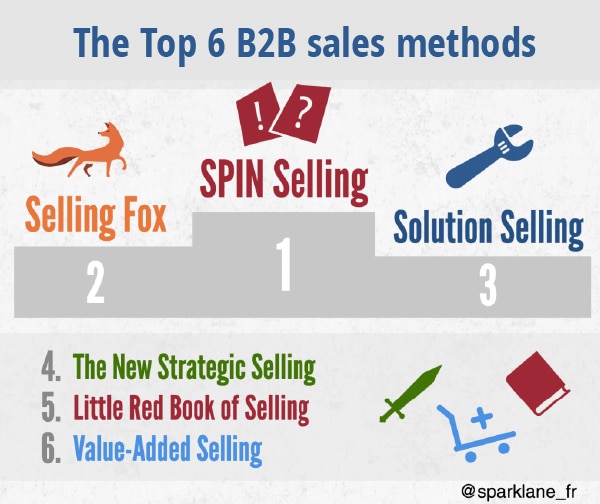
Here’s my (totally subjective) classification of the sales methods. I suggest you take your own look at these landmark B2B selling works, so you can see for yourself.
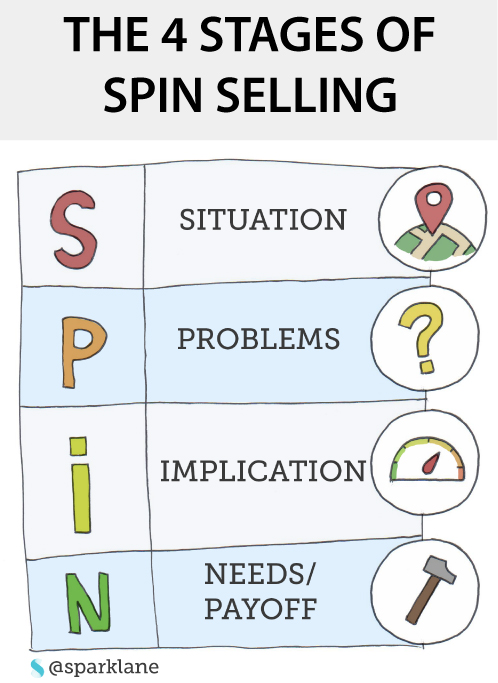
Let’s start with the SPIN Selling method, devised in the 1970s by Neil Rackham and published in 1988: an approach I think can genuinely be described as revolutionary. One by one, this method so successfully dismantled the myths surrounding selling as it was understood in the 1970s that it’s fair to talk of an era “before” and “after” SPIN selling: its introduction marked the point at which complex sales were profoundly changed forever. I won’t attempt to summarise the genesis of Rackham’s study, which you can read about in my article, but I will repeat the conclusion the British author ultimately came to: the same approach that works for a quick sale is not efficient in a complex sale. Complex sales involve a number of different participants on the customer side; the pressure to buy that’s exerted on customers may be effective in a simple sale, but is perceived as unwelcome and irritating in the long term.
Drawing on the fruits of a 10-year study, and following an analysis of the techniques of the best salespeople, Rackham and his team realised that the more customers were allowed to tell their own story, the greater the chance of selling the solution became; conversely, a conversation monopolised by the seller was less likely to lead to a successful sale. Rackham identified a process featuring four types of questions: SPIN for Situation, Problem, Implication (consequences) and Need-payoff (solutions). In practical terms, this involved asking questions about customers’ situations, the problems they faced and the short or long-term consequences of these problems. These were followed by questions about the choice of a relevant solution, leading naturally to the conclusion of the sale.

Key take-home point:
A complex sale is not the same as a simple sale: customers are not buying just a product, they’re also buying a relationship with a sales representative. Furthermore, “complex sale” is often synonymous with “major investment”, meaning that buyers’ budgets and reputations are both at stake. So when they buy, they need to be reassured, and to feel they have been listened to and understood. The 4 SPIN questions cover these factors and provide a great foundation on which to build in a B2B sale. Make sure you include them in your discussion with the customer.
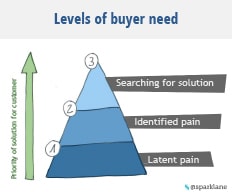
This method ushered in a new era in complex sales, prompting the emergence of a host of similar methods. In particular, the “P” in SPIN was extensively developed by Michael Bosworth in his book “Solution Selling”.
Bosworth closely examined the psychology of customers and the means by which they ranked the degree of urgency of a problem. He identified three levels of need:
A quick question: when prospecting, which customer should a sales rep target? The customer searching for a solution, surely? Actually, no. A good salesperson will approach the undecided customers to ensure they appreciate the importance of the problem, and the potential benefits/savings they stand to enjoy by using the solution. After all, customers searching for a solution account for a tiny fraction of total customers (5%, according to Bosworth). And they may already be in contact with your competitors.
Once you have the customer in front of you, how do you sell them your solution? By offering them a discount, obviously: everyone knows that. But is it true? Tom Reilly – the author of Value Added Selling – believes it’s a serious error, albeit one which is all too common. Customers aren’t looking for a price, they’re looking for added value, which can be summarised as follows:
money invested + associated costs + benefits = value
Reilly suggests 3 stages for building a case based on added value:
Key take-home point:
Each of these methods demolishes a myth. The first – Solution Selling – counters the belief that prospects are identified through strong signals (tender process, stated desire to acquire a solution, etc.). In actual fact, 95% of sales opportunities come from weak signals from a company (hiring, opening a new branch, etc.), which can now be easily detected with Sales Intelligence. The other belief is that customers buy prices. This is obviously false: what they buy is added value. Focus more on your solution’s results, not its prices.
Having put the required effort into the above methods, it’s time to put together your battle plan. After all, selling is a strategy like any other: it requires a study of the terrain, the collection of information on the intended target, and an inspection of your troops before you launch the assault. This is the essence of Heiman and Miller’s Strategic Selling message.
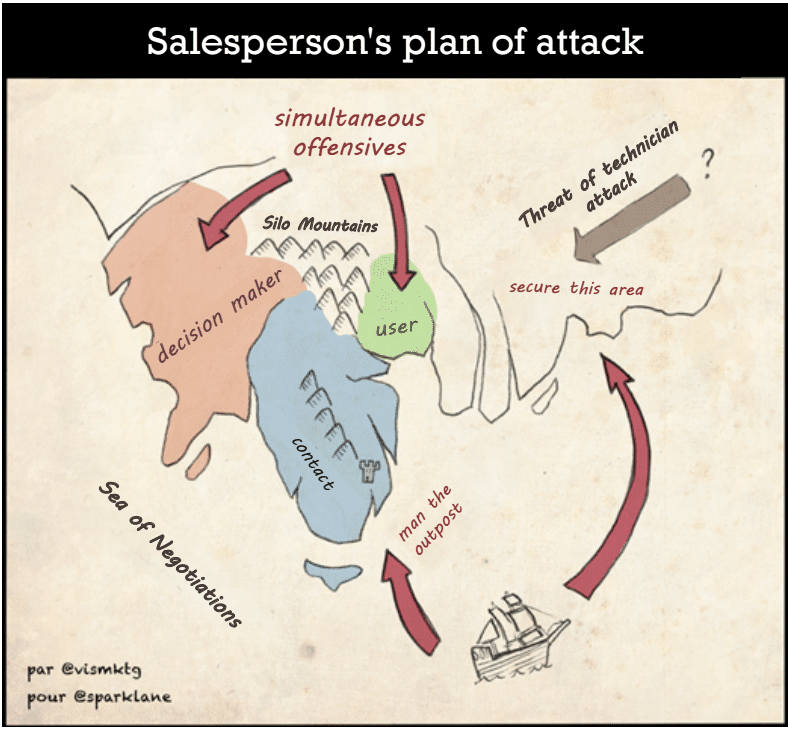
What I found most interesting about this study is the different types of decision-maker Heiman identifies. As I mentioned in my article on Strategic Selling, there are four types: the Economic Buyer, who is the final decision-maker and understands the language of money (ROI, costs, yield, etc.), the User Buyer, who talks in terms of usage (productivity, solution, user-friendliness, etc.), the Coach, who will be your “insider” at the customer, and the Technical Buyer. The latter is an interesting case, which deserves a little more discussion: every sales rep has met one, and is aware of their ability to throw a spanner in the works.
Technical Buyers are extremely clued-up; sometimes more than you are. They see everything in your solution as a problem: price, reliability, targets, delivery timescales, etc. They’ll do everything they can to stall you, including slowing down the discussion with incessant interjections. As a strategist, you’ll need to identify Technical Buyers quickly to “neutralise” them; i.e. talk to them in a one-on-one situation, identify the sticking points and find appropriate answers. If there’s anywhere worth spending your energy, it’s here, because the Technical Buyer is the person with the greatest potential to derail your sale.
Key take-home point:
Make no mistake about it: selling is a battlefield. As in any war, your enemies never come as a unified, omniscient group. They are a group of individuals, each with their own functions, influence, goals and disputes. Identify these people and make good use of the information you hold (especially regarding your Coach) so you can smoothly turn the situation to your advantage.
The four solutions we saw above provide a more or less “scientific” approach to selling, based on studies of best practice. Although also addressing the attitude of the sales rep as well, two other works stand out in particular in this area: The Selling Fox by Jim Holden and the Little Red Book of Selling by Jeffrey Gitomer.
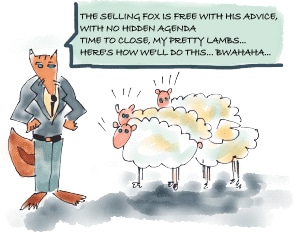
The Selling Fox is a term used by Jim Holden to describe a talented salesperson whose success has a direct impact on turnover, and brings efficiency, speed and support to his colleagues, making him a crucial asset to the company. Holden wanted to find out what made a sales rep a Selling Fox, particularly when it came to closing – the crucial point of a sale at which the customer makes a final decision. Having observed best practices, Holden identified a series of key points:

The 12 principles listed by Gitomer in his Little Red Book of Selling provide some additional information on the attitude the sales rep needs to demonstrate. I’ve condensed them down to four points:
Key take-home point:
Be bold, don’t hesitate, be clear, don’t beat about the bush. These attitudes sum up the attitude you need to adopt. In the end, the Selling Fox adheres to Gitomer’s principles: positive and can-do, his understanding of the customer’s needs and his generosity towards his peers give him an unshakeable confidence, enabling him to close deals without hesitation or fear of failure. Actually, failure is probably the main way we learn.
I’ve taken a lot of personal pleasure in reading and re-reading these sales methods, taking a step back and pondering them again. Experience has taught me one thing: never be complacent or think that just because customers call you of their own accord, you can put your feet up and wait for the phone to ring.
Prospecting and adopting a proactive selling mindset isn’t incompatible with the inbound marketing approach I’ve always advocated. After all, I never said the inbound method prevents you from using this proactive strategy; quite the opposite, in fact. By trying out approaches on new customers, consultants – just like any other sales rep engaged in complex sales – protect themselves against complacency, and step out of their comfort zones. And that encourages creativity – and deal-making. Becoming a Selling Fox doesn’t mean demeaning yourself or “selling out”: rather, it lets you test your working assumptions which, in turn, can feed into inbound content, then be used for outbound strategies too, creating a virtuous selling cycle.
And this is the point at which I break off, somewhat frustrated from reading and examining this handful of books and methods: there’s a sense in which the sales approach remains highly compartmentalised, with each group still occupying its respective corner: “normal” sales on the one side and inbound on the other. Add in a pinch of social selling (which often causes indigestion), and the confusion is complete.
The basic essence of these methods – which were mostly devised in the last century – is visionary in nature, and they remain every bit as effective and applicable with the technological assistance available today. However, although the theory remains valid, practices have changed out of all recognition… so I’ll give you some more personal advice, gleaned from my experience in the field, in a forthcoming article which will round off this series.
Continued and concluded in a future issue.